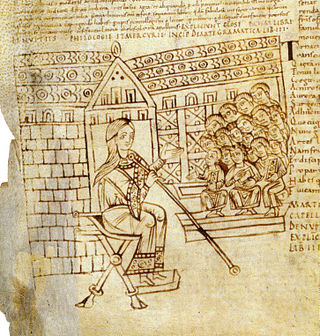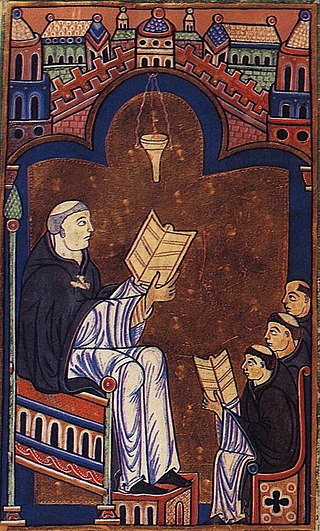
Liberal arts education is the traditional academic course in Western higher education. Liberal arts takes the term art in the sense of a learned skill rather than specifically the fine arts. Liberal arts education can refer to studies in a liberal arts degree course or to a university education more generally. Such a course of study contrasts with those that are principally vocational, professional, or technical, as well as religiously based courses.

From the time of Plato through the Middle Ages, the quadrivium was a grouping of four subjects or arts—arithmetic, geometry, music, and astronomy—that formed a second curricular stage following preparatory work in the trivium, consisting of grammar, logic, and rhetoric. Together, the trivium and the quadrivium comprised the seven liberal arts, and formed the basis of a liberal arts education in Western society until gradually displaced as a curricular structure by the studia humanitatis and its later offshoots, beginning with Petrarch in the 14th century. The seven classical arts were considered "thinking skills" and were distinguished from practical arts, such as medicine and architecture.

The trivium is the lower division of the seven liberal arts and comprises grammar, logic, and rhetoric.

Humanities are academic disciplines that study aspects of human society and culture, including the fundamental questions asked by humans. During the Renaissance, the term 'humanities' referred to the study of classical literature and language, as opposed to the study of religion or 'divinity.' The study of the humanities was a key part of the secular curriculum in universities at the time. Today, the humanities are more frequently defined as any fields of study outside of natural sciences, social sciences, formal sciences, and applied sciences. They use methods that are primarily critical, speculative, or interpretative and have a significant historical element—as distinguished from the mainly empirical approaches of science.

Adelard of Bath was a 12th-century English natural philosopher. He is known both for his original works and for translating many important Greek scientific works of astrology, astronomy, philosophy, alchemy and mathematics into Latin from Arabic versions, which were then introduced to Western Europe. The oldest surviving Latin translation of Euclid's Elements is a 12th-century translation by Adelard from an Arabic version. He is known as one of the first to introduce the Arabic numeral system to Europe. He stands at the convergence of three intellectual schools: the traditional learning of French schools, the Greek culture of Southern Italy, and the Arabic science of the East.

A Bachelor of Arts is a bachelor's degree awarded for an undergraduate program in the liberal arts, or, in some cases, other disciplines. A Bachelor of Arts degree course is generally completed in three or four years, depending on the country and institution.

Eclecticism is a conceptual approach that does not hold rigidly to a single paradigm or set of assumptions, but instead draws upon multiple theories, styles, or ideas to gain complementary insights into a subject, or applies different theories in particular cases. However, this is often without conventions or rules dictating how or which theories were combined.

Vitreous enamel, also called porcelain enamel, is a material made by fusing powdered glass to a substrate by firing, usually between 750 and 850 °C. The powder melts, flows, and then hardens to a smooth, durable vitreous coating. The word vitreous comes from the Latin vitreus, meaning "glassy".

The early Middle Ages, sometimes controversially referred to as the Dark Ages, is typically regarded by historians as lasting from the late 5th to the 10th century. They marked the start of the Middle Ages of European history, following the decline of the Western Roman Empire, and preceding the High Middle Ages. The alternative term late antiquity, for the early part of the period, emphasizes elements of continuity with the Roman Empire, while early Middle Ages is used to emphasize developments characteristic of the earlier medieval period. The time between the 8th and 11th centuries is assigned to the early Middle Ages generally, even by those who extend (late) antiquity to a time well after the 5th century.

Martianus Minneus Felix Capella was a jurist, polymath and Latin prose writer of late antiquity, one of the earliest developers of the system of the seven liberal arts that structured early medieval education. He was a native of Madaura.

The decorative arts are arts or crafts whose aim is the design and manufacture of objects that are both beautiful and functional. This includes most of the arts which make objects for the interiors of buildings, as well as interior design, but typically excludes architecture. Ceramic art, metalwork, furniture, jewellery, fashion, various forms of the textile arts and glassware are major groupings.

Hugh of Saint Victor was a Saxon canon regular and a leading theologian and writer on mystical theology.

Mudéjar art, or Mudéjar style, was a type of ornamentation and decoration used in the Iberian Christian kingdoms, primarily between the 13th and 16th centuries. It was applied to Romanesque, Gothic and Renaissance architectural styles as constructive, ornamental and decorative motifs derived from those that had been brought to or developed in Al-Andalus. These motifs and techniques were also present in the art and crafts, especially Hispano-Moresque lustreware that was once widely exported across Europe from southern and eastern Spain at the time.

During the High Middle Ages, the Islamic world was at its cultural peak, supplying information and ideas to Europe, via Al-Andalus, Sicily and the Crusader kingdoms in the Levant. These included Latin translations of the Greek Classics and of Arabic texts in astronomy, mathematics, science, and medicine. Translation of Arabic philosophical texts into Latin "led to the transformation of almost all philosophical disciplines in the medieval Latin world", with a particularly strong influence of Muslim philosophers being felt in natural philosophy, psychology and metaphysics. Other contributions included technological and scientific innovations via the Silk Road, including Chinese inventions such as paper, compass and gunpowder.

The Speculum maius or "Greater Mirror" was a major encyclopedia of the Middle Ages written by Vincent of Beauvais in the 13th century. It was a great compendium of all knowledge of the time. The work seems to have consisted of three parts: the Speculum Naturale, Speculum Doctrinale and Speculum Historiale. However, all the printed editions include a fourth part, the Speculum Morale, added in the 14th century and mainly compiled from Thomas Aquinas, Stephen of Bourbon, and a few other contemporary writers.

The arts are a very wide range of human practices of creative expression, storytelling, and cultural participation. They encompass multiple diverse and plural modes of thinking, doing, and being, in an extremely broad range of media. Both dynamic and a characteristically constant feature of human life, they have developed into innovative, stylized, and sometimes intricate forms. This is often achieved through sustained and deliberate study, training, and/or theorizing within a particular tradition, across generations, and even between civilizations. The arts are a vehicle through which human beings cultivate distinct social, cultural, and individual identities while transmitting values, impressions, judgements, ideas, visions, spiritual meanings, patterns of life, and experiences across time and space.

During the High Middle Ages, the Chartres Cathedral established the cathedral School of Chartres, an important center of French scholarship located in Chartres. It developed and reached its apex during the transitional period of the 11th and 12th centuries, at the start of the Latin translation movement. This period was also right before the spread of medieval universities, which eventually superseded cathedral schools and monastic schools as the most important institutions of higher learning in the Latin West.
The medieval renaissances were periods characterised by significant cultural renewal across medieval Western Europe. These are effectively seen as occurring in three phases - the Carolingian Renaissance, Ottonian Renaissance and the Renaissance of the 12th century.
The mappae clavicula is a medieval Latin text containing manufacturing recipes for crafts materials, including for metals, glass, mosaics, and dyes and tints for materials. The information and style in the recipes is very terse. Each recipe consists of the names of the ingredients and typically about two sentences on combining the ingredients together. A small minority of the recipes go to about six sentences. The text comes with a short preamble, and other than that it is just recipes. The number of recipes was expanded over the course of the medieval centuries, and some medieval copies have deletions as well as additions, so it is better thought of as a family of texts with a largely common core, not a single text. Most of the Mappae Clavicula recipes are also in medieval Latin in a text known as the Compositiones ad Tingenda.
Lonnie Royce Shelby was an American academic, and Professor Emeritus of Speech Communication and former Dean of the College of Liberal Arts at the Southern Illinois University. He is known for his work on Mediaeval architects and design, especially on the work of Lorenz Lechler, Mathes Roriczer, Hanns Schmuttermayer, Taccola and Villard de Honnecourt. He is also known for coining the term constructive geometry.

















